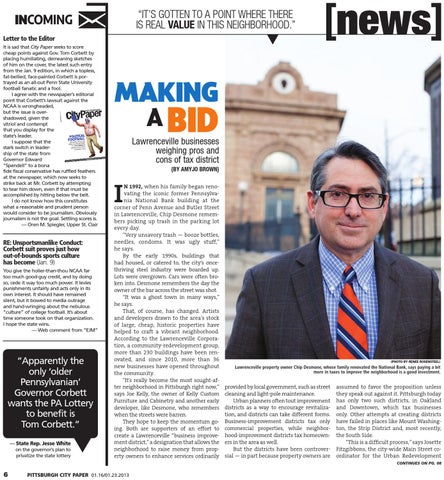“IT’S GOTTEN TO A POINT WHERE THERE IS REAL VALUE IN THIS NEIGHBORHOOD.”
INCOMING Letter to the Editor It is sad that City Paper seeks to score cheap points against Gov. Tom Corbett by placing humiliating, demeaning sketches of him on the cover, the latest such entry from the Jan. 9 edition, in which a topless, fat-bellied, face-painted Corbett is portrayed as an all-out Penn State University football fanatic and a fool. I agree with the newspaper’s editorial point that Corbett’s lawsuit against the NCAA is wrongheaded, but the issue is overshadowed, given the vitriol and contempt that you display for the state’s leader. I suppose that the stark switch in leadership of the state from Governor Edward “Spendell” to a bona fide fiscal conservative has ruffled feathers at the newspaper, which now seeks to strike back at Mr. Corbett by attempting to tear him down, even if that must be accomplished by hitting below the belt. I do not know how this constitutes what a reasonable and prudent person would consider to be journalism. Obviously journalism is not the goal. Settling scores is. — Oren M. Spiegler, Upper St. Clair
RE: Unsportsmanlike Conduct: Corbett suit proves just how out-of-bounds sports culture has become (Jan. 9) You give the holier-than-thou NCAA far too much good-guy credit, and by doing so, cede it way too much power. It levies punishments unfairly and acts only in its own interest. It should have remained silent, but it bowed to media outrage and hand-wringing about the nebulous “culture” of college football. It’s about time someone took on that organization. I hope the state wins. — Web comment from “EJM”
“Apparently the only ‘older Pennsylvanian’ Governor Corbett wants the PA Lottery to benefit is Tom Corbett.” — State Rep. Jesse White on the governor’s plan to privatize the state lottery
MAKING A BID
Lawrenceville businesses weighing pros and cons of tax district {BY AMYJO BROWN}
I
N 1992, when his family began reno-
vating the iconic former Pennsylvania National Bank building at the corner of Penn Avenue and Butler Street in Lawrenceville, Chip Desmone remembers picking up trash in the parking lot every day. “Very unsavory trash — booze bottles, needles, condoms. It was ugly stuff,” he says. By the early 1990s, buildings that had housed, or catered to, the city’s oncethriving steel industry were boarded up. Lots were overgrown. Cars were often broken into. Desmone remembers the day the owner of the bar across the street was shot. “It was a ghost town in many ways,” he says. That, of course, has changed. Artists and developers drawn to the area’s stock of large, cheap, historic properties have helped to craft a vibrant neighborhood. According to the Lawrenceville Corporation, a community-redevelopment group, more than 230 buildings have been renovated, and since 2010, more than 36 new businesses have opened throughout the community. “It’s really become the most sought-after neighborhood in Pittsburgh right now,” says Joe Kelly, the owner of Kelly Custom Furniture and Cabinetry and another early developer, like Desmone, who remembers when the streets were barren. They hope to keep the momentum going. Both are supporters of an effort to create a Lawrenceville “business improvement district,” a designation that allows the neighborhood to raise money from property owners to enhance services ordinarily
{PHOTO BY RENEE ROSENSTEEL}
Lawrenceville property owner Chip Desmone, whose family renovated the National Bank, says paying a bit more in taxes to improve the neighborhood is a good investment.
provided by local government, such as street cleaning and light-pole maintenance. Urban planners often tout improvement districts as a way to encourage revitalization, and districts can take different forms. Business-improvement districts tax only commercial properties, while neighborhood-improvement districts tax homeowners in the area as well. But the districts have been controversial — in part because property owners are
assumed to favor the proposition unless they speak out against it. Pittsburgh today has only two such districts, in Oakland and Downtown, which tax businesses only. Other attempts at creating districts have failed in places like Mount Washington, the Strip District and, most recently, the South Side. “This is a difficult process,” says Josette Fitzgibbons, the city-wide Main Street coordinator for the Urban Redevelopment CONTINUES ON PG. 08
6
PITTSBURGH CITY PAPER 01.16/01.23.2013
